60+ Brand Loyalty Stats You Need to Know

by Daniela Maria Zabrautanu
July 04, 2023
Brand loyalty is a crucial aspect of modern business that cannot be overlooked. In today’s highly competitive market, where consumers are bombarded with numerous options and choices, it is more important than ever for businesses to build and maintain a loyal customer base. Brand loyalty not only leads to repeat purchases but also fosters positive word-of-mouth and customer advocacy, which are invaluable assets for any business. In this blog post, we will delve into the latest brand loyalty statistics, providing you with valuable insights to help them understand and leverage this important aspect of their business strategy. So, let’s dive in and explore the data that shapes brand loyalty. You can also learn more about loyalty programs.
Brand loyalty statistics for 2023
Research on brand loyalty shows the following:
1. Consumer expectations
- 83% of consumers expect personalized experiences from brands they are loyal to (Accenture).
- 91% of consumers are more likely to shop with brands that provide relevant offers and recommendations (Accenture).
- 80% of consumers are more likely to do business with a company that offers personalized experiences (Epsilon).
- 73% of consumers are willing to share their personal information if it leads to a personalized shopping experience (Accenture).
- 72% of consumers will only engage with marketing messages that are personalized and tailored to their interests (Marketing Dive).
2. Social media influence
- 74% of consumers rely on social media to guide their purchasing decisions (Sprout Social).
- 57% of consumers follow brands on social media to learn about new products or services (Sprout Social).
- 66% of consumers engage with brands on social media to show their support or loyalty (Sprout Social).
3. Customer reviews and ratings
- 92% of consumers read online reviews before making a purchase (BrightLocal).
- 88% of consumers trust online reviews as much as personal recommendations (BrightLocal).
- 40% of consumers form an opinion of a brand after reading just one to three reviews (BrightLocal).
Jump to
Brand
Brand loyalty definition:
Brand loyalty refers to the consistent and repeated purchase behavior exhibited by customers towards a particular brand. It is a measure of the customer’s attachment and dedication to a brand, resulting in their willingness to choose and recommend it over competitors. Brand loyalty is built through positive experiences, satisfaction with the brand’s products or services, trustworthiness, and a strong emotional connection. Why brand loyalty is important? Because it is an essential factor in driving customer retention, increasing sales, and establishing a competitive edge in the market.
The Future is Branded: Most Valuable Brands Worldwide in 2023
In 2023, the future of business belongs to the most valuable brands in the world. These brands have successfully built a strong foundation of brand loyalty, which has propelled them to the top of their industries. With consumers becoming increasingly discerning and demanding, these brands have managed to stay ahead by consistently offering exceptional products and services.
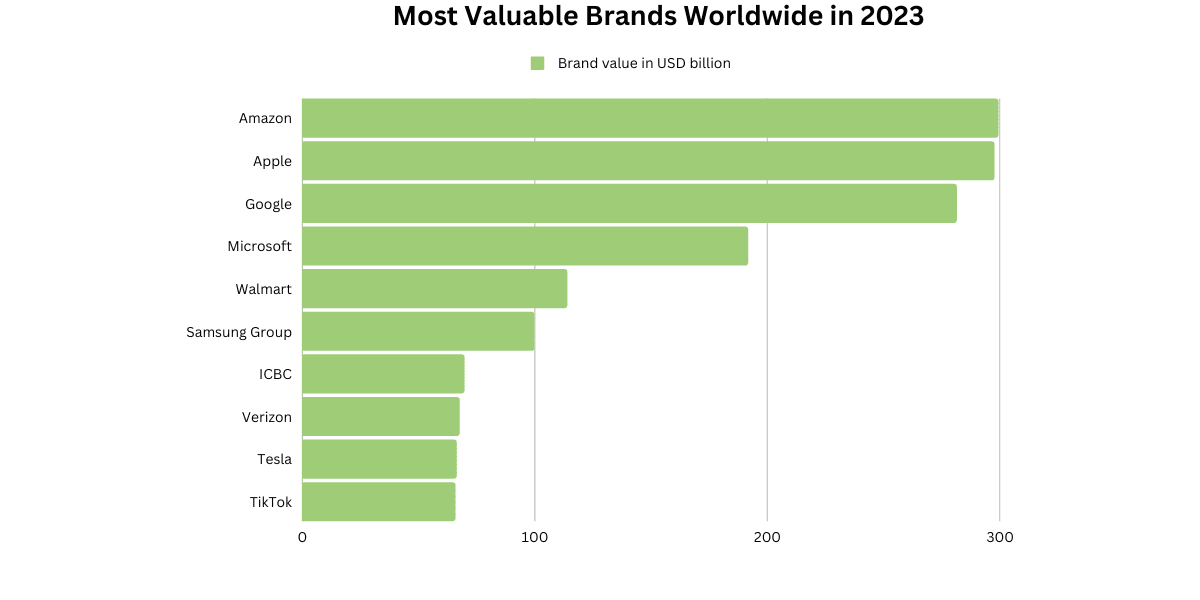
Source: Statista
Unstoppable Growth: Fastest Growing Brands Worldwide in 2023
At Huuray, we know that staying ahead of the competition is crucial. As consumer preferences and market trends evolve, brands must adapt and innovate to maintain their relevance. In 2023, some brands have managed to do just that, experiencing unprecedented growth and capturing the attention of consumers worldwide.
The fastest-growing brands worldwide in 2023 by brand value growth are:
- BYD
- ConocoPhillips
- Mærsk
- Dior
- Tesla
- ADP
- United
- Equinor
Source: Statista
Business Trust Matters: Importance of Trust Among Consumers in the U.S. & Western Europe in 2021
In today’s competitive business environment, besides brand awareness, trust plays a vital role in the success of a brand. Consumers are more discerning than ever before, seeking out brands they can trust and rely on. This is especially true in the U.S. and Western Europe, where the importance of trust among consumers is paramount.
Do consumers think it’s important to trust a brand they purchase from?
This doesn’t come as a surprise. 46% of consumers in the US and selected Western Europe countries strongly believe that trust is an important factor. Other 41% agree with that, and only 13% of consumers are either neutral or disagree.
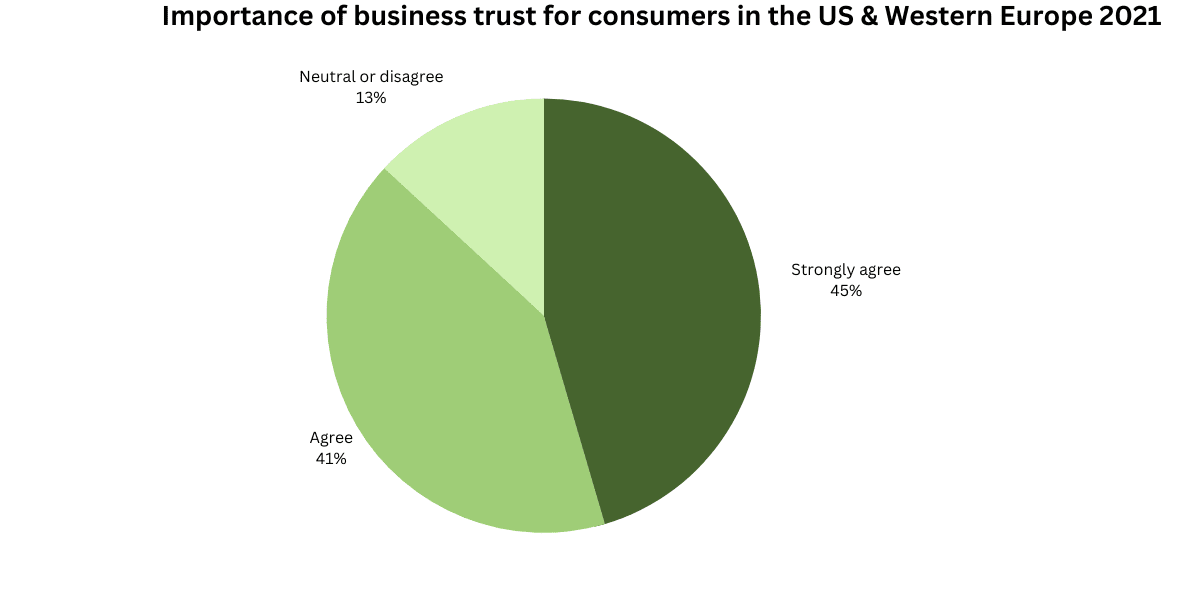
Source: Statista
Trust is a critical factor for consumers when it comes to making purchasing decisions. In fact, a significant percentage of consumers strongly believe that trust plays a vital role in their brand preferences. This is not surprising considering the impact trust has on brand recognition, brand identity, and perceived value.
Brand recognition, or the level of awareness and familiarity a brand enjoys among consumers, is greatly influenced by trust. When consumers trust a brand, they are more likely to remember and recognize it in a crowded marketplace. Trust builds a positive reputation for a brand, making it stand out and remain top of mind when consumers are making purchase decisions.
Additionally, trust plays a pivotal role in shaping a brand’s identity. A brand that is trusted is seen as reliable, credible, and authentic. This perception of a brand’s identity stems from consumers’ confidence in the brand’s ability to consistently deliver on its promises.
Moreover, trust enhances the perceived value of a brand. When consumers trust a brand, they believe that the brand offers value beyond its tangible features. This perceived value is often tied to the emotional connection consumers feel toward a trusted brand.
Building Trust, Inspiring Loyalty: Most Trusted Brands in the U.S. in 2022
In today’s highly competitive market, building trust among consumers is more important than ever for businesses. Trusted brands not only attract and retain loyal customers but also reap the benefits of increased revenue, enhanced brand equity, and improved customer satisfaction. Let’s explore how trusted brands achieve these remarkable outcomes.
Trusted brands understand the value of cultivating long-term relationships with their customers, and this is reflected in the lifetime value of their customer base. The lifetime value of a customer refers to the total revenue generated by a customer over the course of their relationship with a brand. Trusted brands consistently deliver exceptional experiences, which in turn leads to higher customer retention rates and increased customer spending.
Studies have shown that trusted brands tend to have a higher customer lifetime value compared to their competition. When customers trust a brand, they are more likely to remain loyal and continue purchasing from that brand over an extended period. A customer loyalty program also helps with this.
Customer lifetime value is closely tied to customer satisfaction. Trusted brands prioritize delivering exceptional customer experiences, which leads to higher levels of customer satisfaction. Satisfied customers are more likely to remain loyal, make repeat purchases, and even engage in cross-selling or upselling opportunities.
Here are the most trusted brands in the US in 2022:
- Band-Aid
- Lysol
- Clorox
- UPS
- CVS Pharmacy
- Visa
- Cheerios
- The Weather Channel
- Colgate
- Home Depot
Source: Morning Consult
Race to the Top: Nations Experiencing Exponential Growth in Brand Value
In today’s globalized economy, brand value plays a crucial role in determining the success and competitiveness of businesses. As brand value continues to rise in importance, it becomes essential to identify the nations that are experiencing the fastest growth in this area.
According to a 2022 study by Brand Finance, these are the nations with the fastest-growing brand value worldwide by growth rate:
- Serbia: 24%
- Georgia: 24%
- South Africa: 23%
- Tanzania: 23%
- Vietnam: 22%
- Dominican Republic: 21%
- Lithuania: 21%
- Kenya: 19%
- India: 19%
- Costa Rica: 19%
Consumer
Leading retailers with above-average consumer loyalty
Consumer loyalty is a crucial factor for businesses to thrive in today’s competitive market. According to recent statistics, a significant percentage of consumers expect personalized experiences from the brands they are loyal to.
- 83% of consumers expect personalized experiences.
- 91% are more likely to shop with brands that provide relevant offers and recommendations.
This highlights the importance of understanding and meeting consumer expectations to foster loyalty. Social media also plays a significant role in shaping consumer loyalty.
- Around 74% of consumers rely on social media to guide their purchasing decisions.
- 57% follow brands on social media to learn about new products or services.
- 66% of consumers engage with brands on social media to show their support or loyalty.
This underscores the need for businesses to have a strong social media presence and engage with their audience effectively.
Furthermore, customer reviews and ratings have a significant impact on consumer loyalty.
- 92% of consumers read online reviews before making a purchase.
- 88% trust online reviews as much as personal recommendations.
Here are the top retailers with above-average consumer loyalty in the US from July to September 2021 based on a loyalty score (1 to 5) given:
- Walmart: 4.18
- Meijer: 3.26
- Fred Meyer: 2.95
- Costco: 2.52
- Target: 2.5
- The Home Depot: 2.39
- Lowe’s: 2.3
- Dollar General: 2.27
- Sam’s Club: 2.14
- Dollar Tree: 1.86
- US retailer average: 1.37
Source: inMarket
Related: Consumer Incentives: The ultimate guide in 2023
The Loyalty Enigma: Secret Ingredients Fueling Brand Loyalty
Brand loyalty is a coveted goal for businesses across industries, as it not only ensures repeat purchases but also drives customer advocacy and ultimately, business growth. In the highly competitive US market, where consumers have an abundance of choices, understanding the drivers of strong brand loyalty is crucial for brands to develop effective strategies and stay ahead of the game.
Let’s explore the various elements that influence consumers’ allegiance to certain brands in the US market. The percentages below represent the share of respondents that considered the factors “important” or “critically important”.
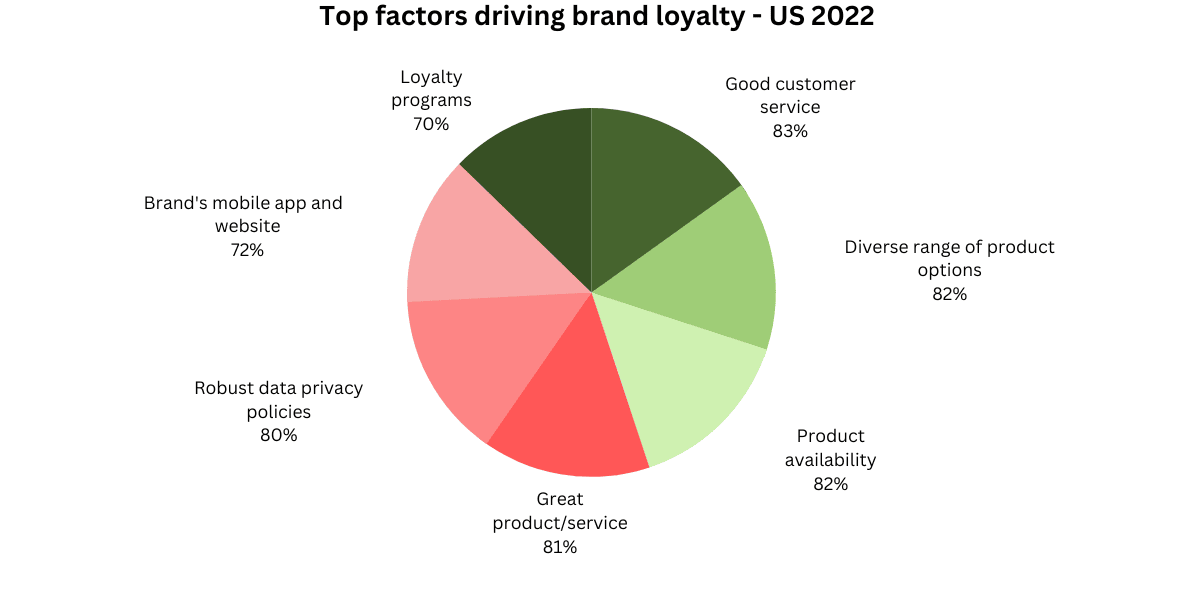
Source: Econsultancy & Marigold
What drives brand loyalty for Gen Z?
High brand loyalty is a powerful force in the consumer market. It refers to the tendency of customers to repeatedly purchase products or services from a particular brand, often at the expense of other options.
When it comes to Generation Z, the cohort born between the mid-1990s and early 2000s, several factors drive brand loyalty. One important driver is authenticity. Gen Z consumers value brands that are genuine, transparent, and align with their personal values. They seek brands that take a stand on social and environmental issues and are actively involved in making a positive impact.
But how important is brand loyalty for this generation and what exactly are the top factors that drive it? We got the answer to that.

Source: Statista
Factors that Influence Consumer Loyalty: The Good and The Bad
Consumer loyalty is a key driver of business success and growth. When customers are loyal to a brand, they not only make repeat purchases but also become advocates, spreading positive word-of-mouth and attracting new customers. However, consumer loyalty is not solely dependent on the quality of a product or service. There are several factors that can influence customer brand loyalty, both positively and negatively. Let’s take a closer look at these factors.
Positive Factors:
1. Quality: One of the most important factors that positively influence consumer loyalty is the quality of a product or service. When customers consistently receive high-quality products or services that meet or exceed their expectations, they are more likely to remain loyal to the brand.
2. Customer Service: Exceptional customer service is another factor that can foster consumer loyalty. When customers feel valued and their concerns are effectively addressed, it strengthens their trust and connection with the brand. Positive interactions with knowledgeable and friendly customer service representatives can significantly impact customer loyalty.
3. Brand Reputation: A strong brand reputation can also contribute to consumer loyalty. Brands that are known for their reliability, credibility, and positive customer experiences are more likely to attract and retain loyal customers. A solid reputation builds trust and reassures customers that they are making the right choice by choosing a particular brand.
4. Personalization: Consumers appreciate personalized experiences and offerings. Brands that take the time to understand their customer’s preferences, needs, and behaviors can create tailored experiences that resonate with their target audience. By offering personalized recommendations, product suggestions, and exclusive offers, brands can make customers feel valued and understood, ultimately driving loyalty.
But the situation in the US in the past two years seems to show a different trend. According to a survey by PwC, these are the factors that have been positively influencing consumer loyalty based on executives:
- Digital distribution accounts for 70%
- Changing customer behavior accounts for 62%
- Changes to the loyalty programs account for 62%
Source: PwC
Negative Factors:
1. Poor Customer Experience: Just as exceptional customer service can foster loyalty, a poor customer experience can have the opposite effect. Customers who consistently have negative interactions with a brand, such as encountering difficulties in resolving issues or receiving subpar products or services, are more likely to switch to a competitor.
2. Lack of Innovation: In today’s fast-paced and ever-evolving market, consumers are constantly seeking new and innovative products and experiences. Brands that fail to adapt and innovate may struggle to maintain customer loyalty. Gen Z, in particular, values creativity and uniqueness, and they are more likely to be loyal to brands that offer innovative and cutting-edge solutions.
3. Ethical and Environmental Considerations: Gen Z is known for its strong sense of social responsibility and concern for ethical and environmental issues. They actively seek out brands that align with their values and contribute to positive change. Brands that are seen as unethical or environmentally irresponsible can quickly lose the loyalty of this generation.
4. Lack of Authenticity: Gen Z values authenticity and transparency. They can easily spot when a brand is being disingenuous or solely driven by profit motives. Brands that lack authenticity in their messaging, marketing efforts, or overall brand ethos may struggle to establish a loyal following among this audience.
However, the last two years in the US tell a different story. The factors that negatively affected customer loyalty in the United States as of November 2022 are:
- 49% of respondents blame Inflation
- 44% say Supply chain disruptions
- 39% believe Talent shortage
Nearly 50% of executives consider inflation as the biggest factor that affects customer loyalty.
Source: PwC
Related: Employee Incentive Programs: The Ultimate Guide to Retaining Top Talent in 2023
Why do consumers not join loyalty programs?
Consumers have various reasons for not joining loyalty programs, which can impact customer loyalty for businesses. Here are a few key factors:
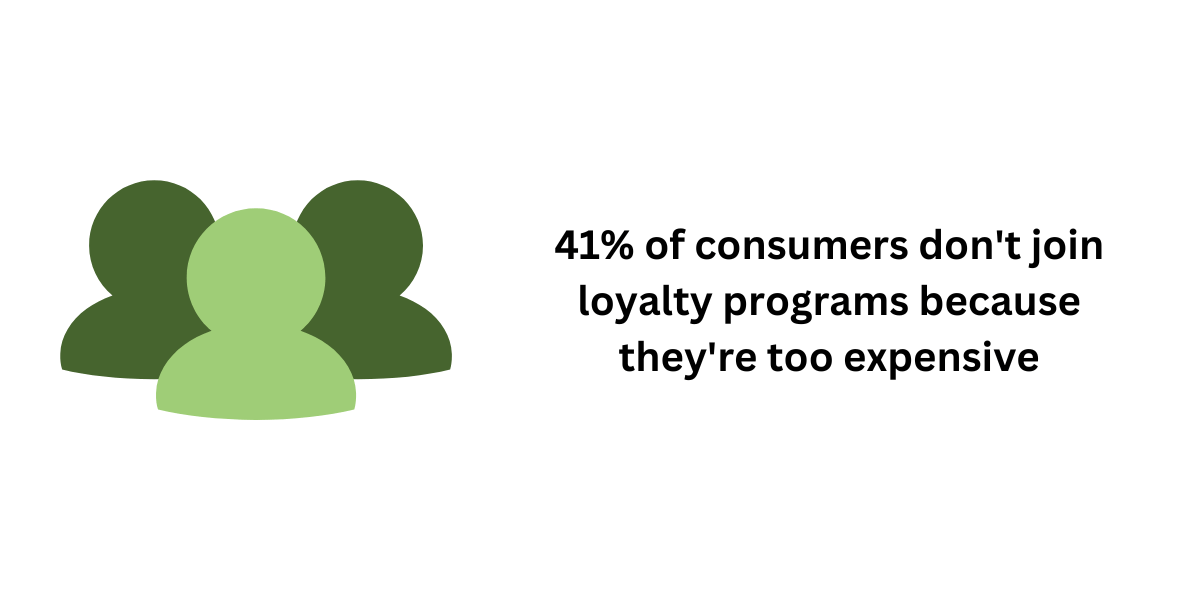
1. Cost:
According to a recent survey conducted by Ebbo, 41% of respondents stated that they do not join loyalty programs because they find them to be too expensive. This finding highlights the importance of cost considerations when designing loyalty programs for businesses.
2. Lack of Perceived Value:
41% of consumers who took part in the survey do not see the benefits or value of joining a loyalty program. If the rewards or incentives offered are not appealing or do not align with their needs and preferences, they are less likely to participate.
3. Not being offered one:
Many consumers are open to joining loyalty programs but have not been offered the opportunity to do so. According to the survey, 31% of respondents expressed a willingness to join a loyalty program if given the chance. This highlights a missed opportunity for businesses to cultivate customer loyalty and drive repeat purchases.
Source: Statista
Resilient Bonds: Consumer Perceptions of Brand Loyalty in Times of Recession
During times of economic downturn, such as recessions, consumer behavior and attitudes toward brand loyalty can undergo significant shifts. Understanding how consumers perceive the benefits of brand loyalty during a recession is crucial for businesses looking to maintain customer loyalty and thrive in challenging economic conditions.
Will a recession influence brand loyalty?
- 50% of consumers say they are going to switch to less expensive brands.
- 37% of consumers will remain loyal to the brand but will purchase less often.
- Only 12% of consumers are not going to change the brands they currently use or adjust the purchase frequency.
Source: UpCity (Statista)
Will a reward or loyalty program make a customer purchase again?
- 75% of consumers say that a reward or loyalty program would make them more likely to make a repeat purchase. (Yotpo)
- 66% of consumers modify their spending habits in order to maximize the benefits they receive from loyalty programs. (Bond Brand Loyalty)
- 57% of consumers are more likely to recommend a brand to others if they are a member of its loyalty program. (HelloWorld )
- 81% of Gen Z and 79% of Baby Boomers will purchase again if they are part of a reward or loyalty program. (Merkle & Statista 2023)
How do consumers show brand loyalty?
Consumers show brand loyalty in various ways, and understanding these behaviors can help businesses design effective loyalty programs. Here are some common ways consumers demonstrate brand loyalty:

Source: Statista
The Motivations of Consumers Joining Loyalty Programs to Showcase Devotion
Joining a loyalty program is a clear indication of a consumer’s brand loyalty. It shows that they are willing to commit to a brand and continue purchasing from it in order to receive the benefits offered by the program. This can include discounts, exclusive offers, or free products.
- 48% of Generation Z join loyalty programs to express loyalty.
- While Millenials and Generation X stand at 49%.
- Baby boomers at only 44%.
Source: Statista
Loyalty programs
Forecasting the Global Market Size and Emerging Trends
According to recent data from Statista, the global market size for loyalty programs is projected to reach a staggering USD 24.44 billion by 2029. This forecast indicates a strong growth trajectory for loyalty programs, highlighting their increasing importance in driving customer engagement and repeat purchases.
Several factors contribute to the predicted growth of the loyalty program market. One key factor is the rising consumer demand for personalized experiences and rewards.
Source: Fortune Business Insights
Related: How Big is the European Gift Card Market? Statistics + Trends
Free version or paid? What’s better and for whom
When it comes to implementing a loyalty program, businesses often face the dilemma of choosing between a free or a paid model. While both options have their merits, it’s important for businesses to understand the advantages and disadvantages of each approach in order to make an informed decision.
Advantages of Free Loyalty Programs:
- Widening Customer Base
- Customer Engagement
- Ease of Implementation
Disadvantages of Free Loyalty Programs:
- Lack of Exclusivity
- Lower Perceived Value
- Limited Revenue Generation
Advantages of Paid Loyalty Programs:
- Exclusivity and Special Treatment
- Higher Perceived Value
- Revenue Generation
Disadvantages of Paid Loyalty Programs:
- Limited Customer Base
- Potential Decrease in Customer Engagement
- Higher Implementation Costs
Ultimately, the decision between a free or paid loyalty program depends on the specific goals and circumstances of the business. If the main objective is to attract a large customer base and increase customer engagement, a free loyalty program may be the better option. On the other hand, if the goal is to create a sense of exclusivity and generate higher revenue, a paid loyalty program may be more effective.
It is also important to consider the target audience and their preferences. Younger generations, such as Generation Z, are more likely to join loyalty programs regardless of whether they are free or paid, as long as they offer attractive rewards and benefits. Baby boomers, on the other hand, maybe more hesitant to join a paid loyalty program and may prefer a free option.
In a survey by Merkle conducted in April 2022 in the US, it was discovered that free and paid loyalty programs have different effects on consumer behavior. Here’s what it found:
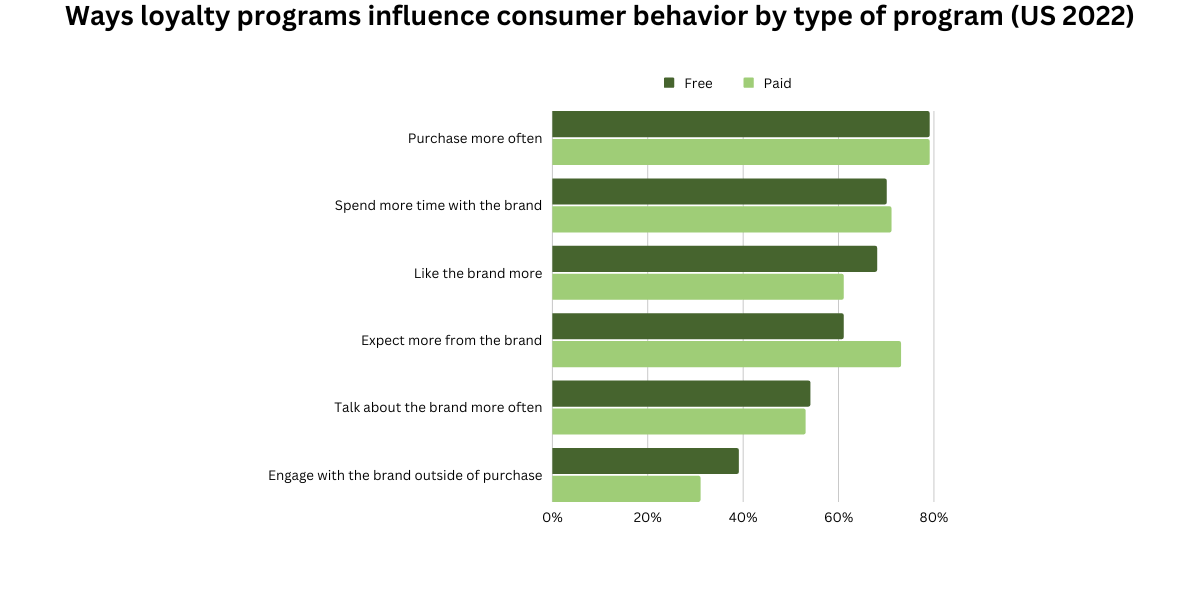
Source: Merkle
How much is invested in loyalty programs worldwide?
According to Statista, companies worldwide dedicated to loyalty programs management and CRM:
- 21.8% of their marketing budget in 2021
- 28.2% of their marketing budget in 2022
The Must-Have Features of Irresistible Loyalty Programs
Loyalty programs have become an integral part of many businesses marketing strategies. By offering rewards and incentives to repeat customers, these programs aim to build customer loyalty, increase customer retention, and ultimately drive sales. However, not all loyalty programs are created equal. In order to be effective, loyalty programs need to have certain desirable features that appeal to customers and encourage their participation.
According to a 2022 study by Econsultancy and Marigold, these are the most desirable features of loyalty programs as stated by consumers:
- 61% value discounts
- 58% want points or rewards
- 30% appreciate exclusive or early access to products
- 26% want personalized products recommended based on their preferences
- 26% care for brands to communicate with them on their preferred channels
- 18% desire sweepstakes and contests
- 16% want to feel part of the brand’s community
- 14% of respondents value brand recognition
Source: Statista
Related: 32 Corporate Gift Ideas That Will Make You Stand Out
What generation is more likely to join a loyalty program?
When it comes to joining loyalty programs, different generations have varying preferences and tendencies. Younger generations, such as Gen Z, are more likely to join loyalty programs regardless of whether they are free or paid, as long as they offer attractive rewards and benefits. This generation is highly driven by the desire for discounts, points or rewards, and exclusive access to products.
On the other hand, baby boomers may be more hesitant to join a paid loyalty program and may prefer a free option. While they still value discounts and rewards, they may not be as interested in exclusive access or personalized recommendations. Baby boomers are more likely to value being part of a brand’s community and appreciate brand recognition.
A study by Ebbo and MarketingCharts gives us the exact numbers of consumers in the US in 2022 who want to join a loyalty program:
- 87% of Gen Z are planning to join
- 85% of Millenials
- 79% of Gen X
- 61% of Baby boomers
- 46% of the Silent generation
Source: Statista
Conclusion
In conclusion, this blog post highlights the most important aspects and statistics of brand loyalty, consumer loyalty, and loyalty programs. The data shows that a majority of consumers, across different generations, are interested in joining loyalty programs that offer value, discounts, points or rewards, and exclusive access to products. It is evident that these features are highly desirable and can effectively drive customer participation and engagement.
Ultimately, the statistics paint a compelling picture of the intricate interplay between brands, consumers, and loyalty programs. By recognizing the power of brand loyalty, understanding consumer motivations, and delivering compelling loyalty program experiences, businesses can position themselves for long-term success in an increasingly loyalty-driven world.



Let’s have a chat
Frequently asked questions
Brand loyalty can become a problem for retailers in several ways. While having loyal customers is generally seen as a positive outcome, there are potential drawbacks that retailers need to be aware of and address. Here are a few ways brand loyalty can become problematic for retailers:
1. Lack of exploration: Consumers who are highly loyal to a particular brand may become less likely to explore alternative options. This can prevent retailers from attracting new customers and expanding their customer base.
2. Resistance to price changes: Loyal customers may be less sensitive to price changes, making it difficult for retailers to adjust their pricing strategies. This can be problematic if the retailer needs to increase prices due to rising costs or if they want to offer promotions to attract new customers.
3. Decreased responsiveness to marketing efforts: Brand loyal customers may become less responsive to marketing campaigns and promotions, as they already have a strong affinity for the brand. This can make it challenging for retailers to effectively communicate new offerings or incentives to these customers.
4. Resistance to change: Brand loyal customers may resist changes in the brand’s product offerings, design, or overall strategy. This can hinder retailers’ ability to adapt to changing market trends and consumer preferences.
In today’s digital age, building customer trust and loyalty is crucial for the success of any company. With the prevalence of online shopping and the vast amount of choices available to consumers, establishing a strong brand identity and reputation is more important than ever. Digital marketing plays a crucial role in achieving this, as it allows companies to connect with their target audience, build relationships, and foster trust. In this blog post, we will explore some effective strategies that digital marketers can use to build customer trust and loyalty in a company’s brand.
1. Consistent Branding: One of the first steps in building trust and loyalty is to have a consistent brand across all digital channels.
2. Authentic Content: Authenticity is key in the digital marketing world. Consumers are becoming increasingly savvy and can easily spot inauthentic or overly promotional content. To build trust, provide valuable and relevant content that genuinely helps your audience.
3. Social Proof: People are more likely to trust a brand that has positive reviews and testimonials from real customers. IncorporatingHow can brand loyalty become a problem for retailers?
Measuring brand loyalty is crucial for businesses to understand the effectiveness of their strategies and initiatives. Here are some ways to measure brand loyalty:
1. Customer surveys: Conducting surveys can help gather feedback from customers regarding their satisfaction and loyalty towards your brand.
2. Repeat purchase rate: Analyze how often customers make repeat purchases from your brand. A high repeat purchase rate indicates a strong level of brand loyalty.
3. Customer retention rate: Calculate the percentage of customers who continue to do business with your brand over a specific period.
4. Net Promoter Score (NPS): NPS measures customers’ likelihood to recommend your brand to others. It is calculated based on a scale of 0-10, with customers categorized as promoters (9-10), passives (7-8), or detractors (0-6). Subtracting the percentage of detractors from promoters gives you the NPS.
5. Social media engagement: Monitor the level of engagement and interaction on your brand’s social media platforms. High engagement, such as likes, comments, and shares, indicates a strong connection and loyalty from your audience.
6. Customer reviews and testimonials: Analyze customer reviews and testimonials to gauge their satisfaction and loyalty towards your brand. Positive reviews and testimonials reflect a higher level of brand loyalty.
Building brand loyalty is essential for the long-term success of any business. Here are some strategies you can implement to build brand loyalty:
1. Provide exceptional customer service
2. Offer a superior product or service
3. Create a personalized customer experience
4. Implement a loyalty program
5. Engage with your customers on social media
6. Build brand advocacy